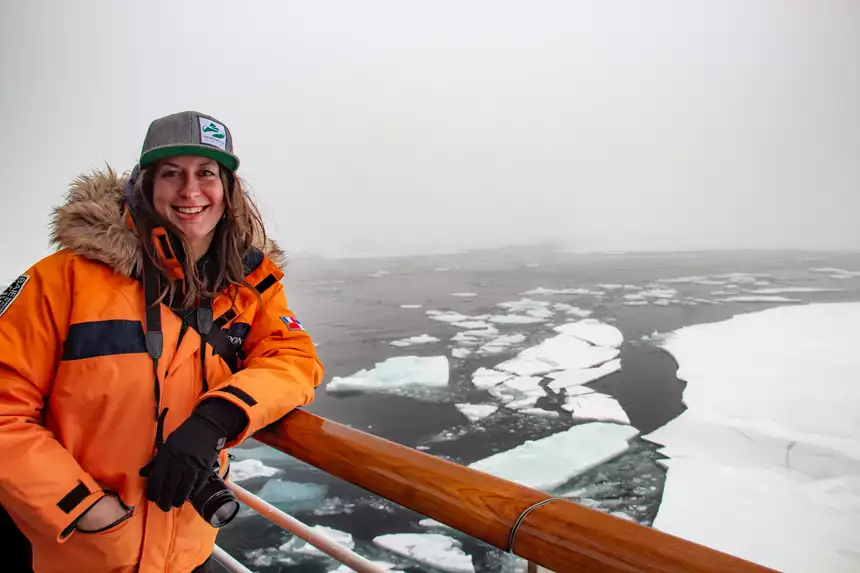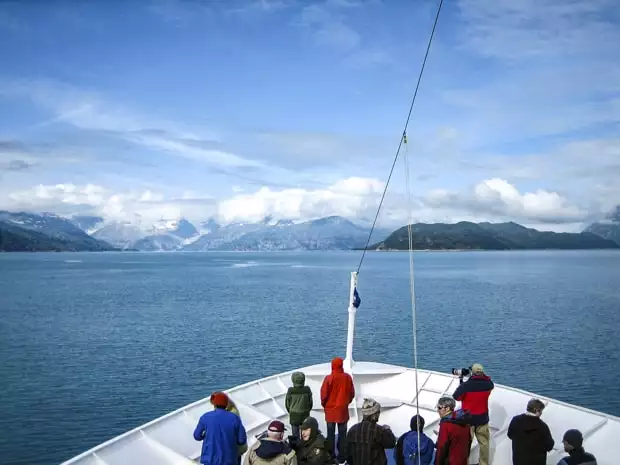As small ship cruise experts we are often asked about seasickness. While most small ship cruises travel close to shore where seasickness is not an issue, some expedition cruises can encounter rough seas. Ocean conditions vary widely depending on the destination, season, weather, type of ship, route and many other factors. While we cannot predict the sea conditions on any given cruise, we can help travelers determine the level of risk in encountering rough seas and we can provide advice on how to treat and prevent seasickness on cruises.
Our well-traveled experts here at AdventureSmith, including some extremely prone to sea sickness and others not, have compiled this guide to preventing and treating seasickness on small ship cruises.
IN THIS POST – Treating Cruise Travel Sickness:
What is Seasickness/Motion Sickness?
Our Prevention Tips
Treatment Options
View popular Cruise Destinations
What is Seasickness or Motion Sickness?
Seasickness is thought to be caused by mixed signals sent to the brain by the eyes and balance sensors in the inner ear. If you cannot see the motion your body is experiencing (for example inside a ship’s cabin), or conversely if you cannot feel the motion your eyes see, then your brain gets confused. Regardless of the cause, the feeling is unpleasant and symptoms include dizziness, nausea, sweating, vomiting and a general sense of feeling unwell.
Seasickness has other causes than just rough water. Some people can become seasick by suggestion, studies have shown. They convince themselves that being on a ship will make them sick, while others ride out the waves with little or no ill effects. Some people are simply more susceptible to motion sickness than others. If you know you are susceptible, take precautions before your cruise.

TALK TO A CRUISE EXPERT
You’ve got questions.
We’ve got answers.
How to Prevent Seasickness
The best method to avoid the unpleasant effects of seasickness is to prevent them from occurring in the first place. There are several strategies to prevent seasickness before it happens.
Consider Your Cruise Destination
Some cruise destinations are more susceptible to rough seas than others. Cruise itineraries with long open-ocean crossings like Antarctica (its infamous Drake Passage pictured above right on a rough day) are particularly seasick-inducing while itineraries in protected waters, such as Alaska’s Inside Passage (pictured above left), are often calm. A destination like the Galapagos (pictured center) often has a mix of sea conditions.
Choose the Right Cabin
Small cruise ships are uniquely susceptible to movement and will feel the motion of the ocean more so than a big cruise ship. Choose a cabin mid-ship (centered between the bow and stern/front and back of the ship) and lower on the ship. Be sure to choose a cabin with a view window (don’t go so low that you have no window or only a small porthole). Many small ships now offer cabins with balconies, which can be great for seasickness, but are often located on the top deck. Balance your concerns about seasickness with your desire to maximize enjoyment of your cruise.
VIEW ALL SMALL SHIPS
See all the small ship options worldwide.
Eating & Drinking Tips
Be well rested and in good health before the cruise. Be careful about eating certain foods, caffeinated drinks and alcohol. Avoid things that do not agree with you. Strong food odors may also aggravate symptoms. Don’t travel on an empty stomach as this can promote symptoms. Staying hydrated and eating small meals frequently can help.
Prepare in Advance
Small ship captains usually know in advance if the cruise will experience rough seas and typically make an announcement. Heed this warning and take medications, put on wristbands or take precautionary measures before any symptoms occur. Usually once symptoms occur it is too late and medications or other measures are less effective.
Onboard Tips
Choose a seat or location on the ship with the least amount of movement. This is usually mid-ship and low on the ship. Fix your gaze on the horizon as this can help reconcile the mixed signals your brain is receiving. Get some fresh air by opening a window or going on deck. Isolate yourself from other guests who are seasick. Hearing others talk about symptoms or watching them become ill can result in ill feelings yourself. Some say it is contagious in this way. Don’t read to relax as this can aggravate the mixed signals in your brain.

PICTURE YOURSELF HERE
Make it happen
by staying in the loop.
How to Treat Seasickness
There are a number of seasickness treatments, from drugs to natural remedies and acupressure bands. Not every solution works for every traveler and you may need to try several to determine which works best for you. If you have previously experienced motion sickness you may know the best remedy. If not, it is best to be prepared with a number of treatments. Hopefully you won’t have to use any of them.
Drug Remedies
Commonly used drugs to treat seasickness include antihistamines and scopolamine. Antihistamines are the most commonly used and widely available medications to treat motion sickness. Antihistamines are not as effective as scopolamine, but they are popular with travel doctors because they produce fewer adverse effects. The list of possible drug treatments is long; we have provided a sampling of the most commonly used treatments.
Please note that we are travel experts, not medical professionals. Visit your doctor to determine the best seasickness treatment for you. Before taking any medications read the precautions as many medications have side effects that include dry mouth, blurry vision, drowsiness and occasionally disorientation.
Antihistamines
The most popular over-the-counter antihistamines are dimenhydrinate (known as Dramamine) and meclizine (known as Bonine). Both are taken orally and should be taken one hour before rough seas are encountered. Promethazine (known as Phenergan, Phenadoz and Promethegan) is available by prescription and may be the most effective of the antihistamines for the treatment of seasickness.
Scopolamine
Commonly known as “the patch” and sold under the brand name Transderm Scop, scopolamine is available by prescription and works by blocking the brain signals that cause queasiness. The small patch is placed behind the ear and releases small amounts of the drug that is absorbed directly into the bloodstream over a 72-hour period. The patch is a great option for who know they are prone to seasickness as it’s a set-it-and-forget-it style remedy.




Natural Remedies
The most common drug-free seasickness remedy is the Sea-Band wristband. The acupressure-inspired bands are easy to wear and place a plastic bead against a pressure point on the palm side of your wrist. Because the bands do not use drugs they do not cause any of the side effects associated with anti-nausea drugs. Some travelers swear by these bands while others claim no relief at all. Sea-Band wristbands are available without a prescription in adult and child sizes.
Another useful natural remedy is ginger. Many travelers promote the benefits of ginger and some studies have shown to alleviate nausea associated with sea sickness without causing drowsiness. Ginger can be taken in various forms including powder, pills, tea and candy. Ginger cookies and ginger ale are a delicious way to administer this natural remedy. Some experienced cruisers also believe that eating green apples can help with nausea, and most ships will have apples and crackers available to guests.
Don’t let seasickness adversely affect your next small ship cruise. Take the advice of AdventureSmith experts, and your next cruise will be smooth sailing.

GET OUR EXPERT ADVICE
More questions?
Let us answer.
This blog detailing how to prevent and treat seasickness aboard a small cruise ship is among AdventureSmith Explorations’ extensive travel resources. Visit our Small Ship Cruise Guides page for even more tips and inspiration to plan your cruise, and read Todd’s interview with the Washington Post on the topic of seasickness for further information.

Comments will be moderated and will appear after they have been approved.